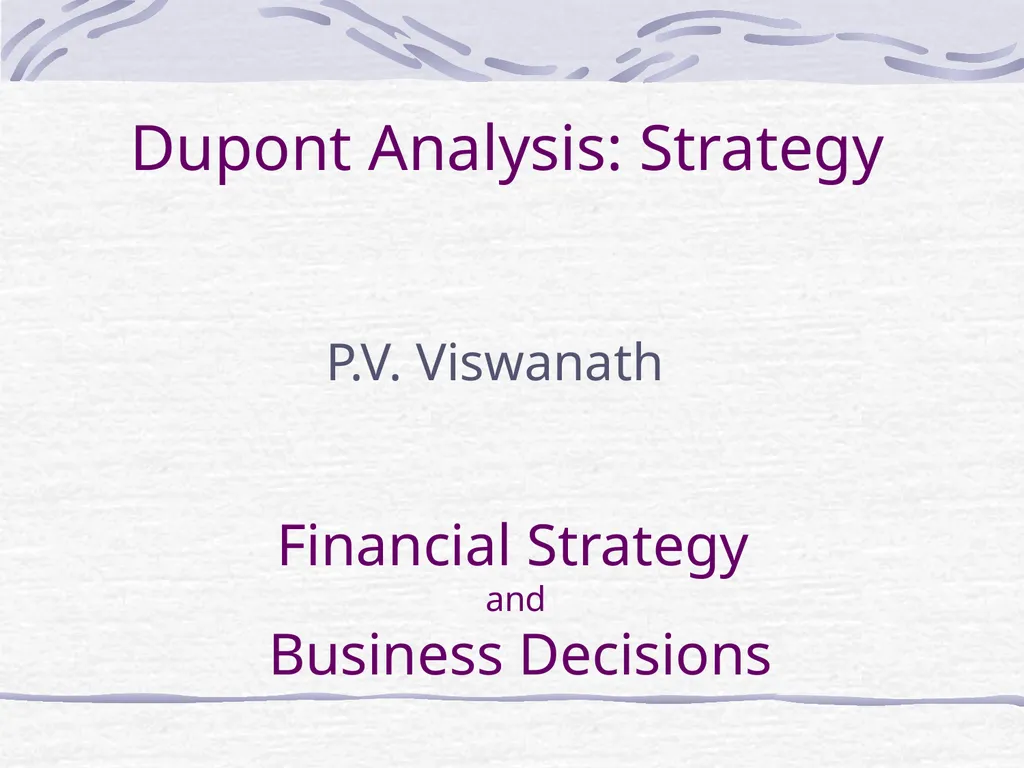Dupont Analysis: Strategy P.V. Viswanath Financial
Author : tawny-fly | Published Date : 2025-06-23
Description: Dupont Analysis Strategy PV Viswanath Financial Strategy and Business Decisions Topics Alternative Decomposition of the Dupont Model Generic Competitive Strategies and the Dupont Model Interactions between Accounts Receivable and Sales
Presentation Embed Code
Download Presentation
Download
Presentation The PPT/PDF document
"Dupont Analysis: Strategy P.V. Viswanath Financial" is the property of its rightful owner.
Permission is granted to download and print the materials on this website for personal, non-commercial use only,
and to display it on your personal computer provided you do not modify the materials and that you retain all
copyright notices contained in the materials. By downloading content from our website, you accept the terms of
this agreement.
Transcript:Dupont Analysis: Strategy P.V. Viswanath Financial:
Dupont Analysis: Strategy P.V. Viswanath Financial Strategy and Business Decisions Topics Alternative Decomposition of the Dupont Model Generic Competitive Strategies and the Dupont Model Interactions between Accounts Receivable and Sales Interactions between Accounts Payable and Purchases. Standard Dupont Analysis ROA = NI/TA = (NI/Sales) x (Sales/TA) = (Net Profit Margin) x (Asset Turnover) ROE = NI/TE = ROA x (TA/TE) = (NI/Sales) x (Sales/TA) x (TA/TE) = Net Profit Margin x Asset Turnover x Equity Multiplier Blunt instrument to monitor strategy because The denominator in the ROA includes assets claimed by all providers of capital, while the numerator includes only return to providers of equity. Assets include operating assets and financial assets Net income includes income from operating activities, as well as interest income and expense, which are the consequence of financial decisions. Alternative Decomposition The key is to divide assets into operating assets and non-operating (or financial) assets, and similarly the liabilities into those associated with the firm’s operations and those that are financial and hence not associated with the firm’s operations. Some of the firm’s long-term liabilities are non-interest bearing, such as pension obligations, which are really part of the firm’s operations rather than its financing – because they represent labor compensation. We net the firm’s long-term assets net of these non-interest bearing liabilities to get Net long-term assets. Similarly, we would like to create a category of short-term assets that includes all short operating assets, net of all short-term operating liabilities. This gives us Operating Working Capital, defined as (Current Assets – Cash and Marketable Securities) – (Current Liabilities – Short term debt and current portion of long-term debt). Net Assets = Net long-term assets + Operating Working Capital Net Debt = Total interest bearing liabilities – Cash and Marketable Securities (Cash is typically treated as negative debt, which is debatable.) Alternative Decomposition Similarly, we isolate and use net operating profit, rather than using Net Income (which includes interest). This is done by adding back interest expense to net income, after adjusting for their tax impact. Similarly, interest income. Thus, we first define (NIntAT) Net Interest expense after tax as (Interest expense – Interest Income)x(1-Tax rate). Then Net Operating Profit After Taxes (NOPAT) = Net Income + Net Interest Expense after taxes; and Net Income = NOPAT – NIntAT. Alternative Decomposition ROE = (NOPAT/Equity) – (NIntAT /Equity) = (NOPAT/Net Assets) x (Net Assets/Equity) – (NIntAT)/Net Debt) x














